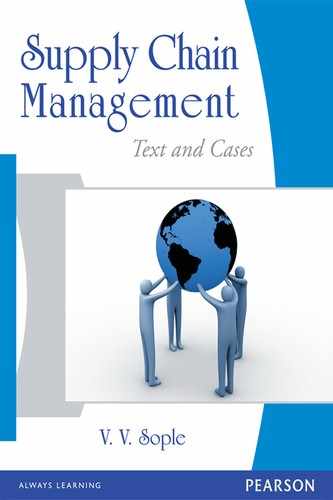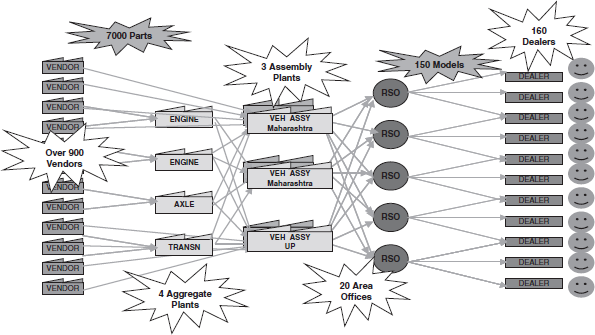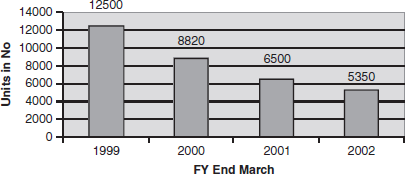Case 8
Padmini Motors Ltd1
A Lean Supply Chain Through ‘Just-in-Time’ System
After the liberalization of the Indian economy in 1991, the auto sector was one of the first few industries to face the stiff competition from the foreign MNCs, which started putting their foothold on the Indian soil to tap the green market. The auto manufacturers lost their government protection umbrella and had no other alternative but to remain competitive by developing cost-based or differential-based competitive strategies. Within the short span of 5–6 years, the market was flooded with world-class passenger car models and multi-utility vehicles produced in India by the world auto giants like, Ford, Mercedes, Hyundai, Toyota and so on.
Company Profile
Padmini Motors Ltd (PML) was amongst the old Indian veterans having started manufacturing auto vehicles way back in the 1950s having its first plant in Mumbai manufacturing a sturdy vehicle jeep in a single model to suit the poor road conditions prevailing then. Padmini had a virtual monopoly in jeep markets commanding 85 per cent of market shares till 1991. After liberalization the scene changed. It became buyers market rather than sellers’ market, which was prevailing prior to 1991. One world-class manufacturer and one old Indian player entered in Indian market with a large number of multi-utility vehicle models, giving more choice to the Indian customers. In the GPL (globalized, privatized and liberalized) economic environment Padmini lost its monopoly and its share reduced to 55 per cent. Two other players shared the balanced market equally. In the changed competitive environment, Padmini observed the following:
- Heightened customer expectations
- Faster new product introduction
- Shortening of product life cycle
- Intense competition race for market share
To remain competitive and arrest the declining market share, Padmini adopted both cost-based and differentiation-based marketing strategy. However, for the cost-based strategy Padmini decided to focus on its supply chain to take cost out so as to make supply chain more lean.
Padmini is currently manufacturing around 60,000 multi-utility vehicles per annum. The product range covers 150 models. The firm has three main assembly plants of which two are located in Maharashtra and one is located in Uttar Pradesh. The assembly plants are supported by four subassembly plants exclusively dedicated to engines (two), axle and transmission gears. The firm has a vendor base of over 900 suppliers for 7,000 parts. The vendors are located in and around, Mumbai, Delhi and Vapi. Padmini is marketing its products through 20 area offices, which are controlling the network of 160 Padmini dealers spread across the country.
Padmini employees a local work force of about 2,000 skilled personnel intensively trained in their areas of specialization. The company endorses equal opportunities and encourages women's participation in the organization's growth. The company has exports contributing to 10 per cent of its sales turnover. The Padmini products are well accepted by the local and international buyers because of its world-class quality and the back up after sales service offered by the company to its clients.
Paradigm Shift
The company has gained its reputation over the consistent efforts in making available to its clients the quality products and a variety of models to suit their requirements. The real efforts stared after the liberalization when the company got the first jolt by way of substantial reduction in its market share in subsequent years. To counter the competition and remain differentiated, the company focused on its supply chain (Figure 1). It adopted the concepts of JIT (Just-in-Time) based on the ‘Toyota Production System’.
Traditionally the company was planning its production on the forecasts, which was based on the customer demand trends observed in the past. The prevailing practices were as follows:
- Monthly requirements of sales based on forecast
- Monthly production plan based on requirements of sales
- Production plan translated into schedules
- Vendor schedules based on production plan
- Frequent changes in production plan due to demand variations
- Corresponding changes in vendor schedules
To Create a Demand Pull
The push system, which was based on forecast, proved wrong due to change in the customer's taste, and the demand pattern and competition. The production panned on the basis of forecasts was either inadequate or in excess of the actual demand. This resulted in excessive inventory to meet the desired level of customer service. The products thus manufactured were pushed through the dealer's network to sell. To get over this problem the company decided to adopt the principle of ‘sell one make one’ and go in for the pull system so as to let production be demand driven rather than forecast driven. They integrated its distribution, manufacturing and procurement operations by using latest IT tools and connectivity equipments based on the latest technologies. The firm now had all the supply chain participants on line with each other with proper information sharing security policy. The current practices under the newly introduced pull system are as follows:
- Replenishment action to start from dealers
- Dealer sales replenished by regional sales office
- Sales from regional sales office replenished from the fresh production
The firm had reviewed its product range and regrouped its products into two categories, that is, 33 models contributing to 88 per cent of the company's sales and 117 models contributing to 12 per cent of sales (Exhibit 1).
It was further decided that only FMG would be carried in the buffer stocks, while the SMG models will be strictly manufactured against the firm orders. The buffer quantity for replenishment worked out, considering the following:
- Forecasted average retail sales
- Lead time variable factor (considering logistics slipups)
- Demand variable factor (seasonal, short-term and regional pattern)
Thus getting daily orders from the dealers for FMG and SMG models created the demand pull. With the buffer maintained at the depots, the dealer's requirements for FMG models were fulfilled within 48 hours from the regional offices. The weekly orders (firm) from regional offices were sent to plants on both FMG and SMG models for replenishment.
Planning and Scheduling
To support the field requirements, Padmini stressed on the planning and scheduling of the manufacturing activities. The firms adopted a system of preparing and rolling out the quarterly sales forecast for planning its manufacturing capacity and resources and preparing its monthly production plans. The firm has clear distinctions between the manufacturing planning and scheduling. The planning was for capacity booking and organizing resources while the scheduling was for resources allocation and actual physical production of the product on the shop floor. From the traditional practice of monthly production schedule Padmini had shifted to weekly production schedules to meet the replenishment at regional sales offices. The weekly schedules were further refined by the daily replenishment requirement from the regional sales offices, which were further getting the replenishment requirement from the dealers on a daily basis.
Flexible Manufacturing
To support the pull system, Padmini had further adopted and implemented the concept of ‘let demand drive the production’ with the following objectives:
- Hundred per cent order fulfilment
- Reduction in order-to delivery time
- Minimum pipeline inventory
To attain the objectives, the company had identified four key thrust areas such as manufacturing flexibility, synchronous production of aggregate, increase in frequency of ordering, and speed, frequency and automation of the information-processing system. The company heavily invested in latest IT tools like EPR and installed SAP for supply chain coordination on real-time basis. The company had gone for manufacturing flexibility by regrouping its critical assemblies/components (Exhibit 2) into two categories, that is, stocks and make-to-order.
For all the assemblies and components the delivery lead time was planned as 24 hours. However, the buffers were maintained for FMG assemblies and components and for SMG, it was decided to manufacture the same against actual orders. The firm went for daily order processing for faster fulfilment of orders as against the weekly earlier. The KANBAN system was introduced to have the speedy replenishment at the assembly line from the sub-assembly and components stores.
Material System
To support the flexible manufacturing, the demand pull was further extended to vendors. The material system was devised to ensure the availability of all materials to meet the scheduled production of the sub-assemblies and vehicles with simultaneous reduction in acquisition costs. Padmini used the latest tool for inventory planning and KANBAN for material scheduling. Over 90 per cent of material was put on the KANBAN replenishment system for speed, accuracy and reliability.
Padmini has a wide base of 900 vendors spread across the country. For the reliable and speedy deliveries the entire inbound logistics activities were outsourced to 3 PL firm for transportation and storage at various points. The firm divided its vendors into seven zones (Exhibit 3) for its plants. The 3 PL firm was responsible for the daily milk run (in each zone) to collect the material as per the schedule to either send it to the plant warehouse in case of the full truck load or keep it at the hub warehouse in the zone for getting the truck load filled for dispatch to plants.
Exhibit 3 Vendor Base for Milk Run
| Zones | Vendors | Parts |
|---|---|---|
| Nashik | 27 | 325 |
| Delhi | 30 | 180 |
| Bangalore | 18 | 176 |
| Chennai | 20 | 165 |
| Pune | 17 | 90 |
| Daman | 10 | 65 |
| Total | 110 | 1,194 |
The limits for stock levels at the hub was always 1 day and daily shipments were panned from hub to plants with limitation on transit time (5 days from Delhi to Nashik or other plants) to meet the JIT requirements at the plant.
Achievements
As a result of supply chain initiative Padmini achieved its strategic objective of cost leadership. The firm's products are price competitively in the market and command comfortable margins as compared to the competition. The inventory-related cost is reduced to more than half as compared to the level 4 years back. The average finished goods inventory level has come down to 5,350 in 2002 from 12, 500 in 1999 (Figure 2). For differentiation-based objective, the firm has a very wide product range of 150 models for the customers to choose from and is supported by the network of the countrywide service centres for the after sales service. With the enhanced service level backup, the customer satisfaction level is much above as compared to the nearest competitor, which is half of that enjoyed by Padmini. Even though the market share of Padmini did not grow, the supply chain management initiative helped the company to improve its profit margins and customer service.
REVIEW QUESTIONS
- Compare and contrast the SCM and traditional approach of Padmini to service the market.
- Discuss the role of 3 PL partner in meeting the strategic objectives set by the company.
- What are the system inputs Padmini had planned for the SCM initiative to be successfully implemented?
- For flexible manufacturing what are the challenges and limitations?




